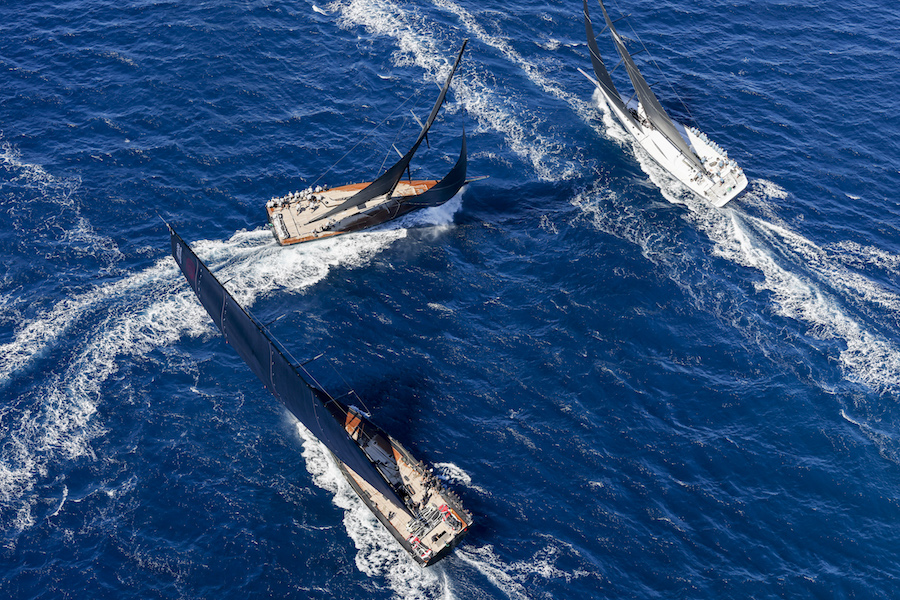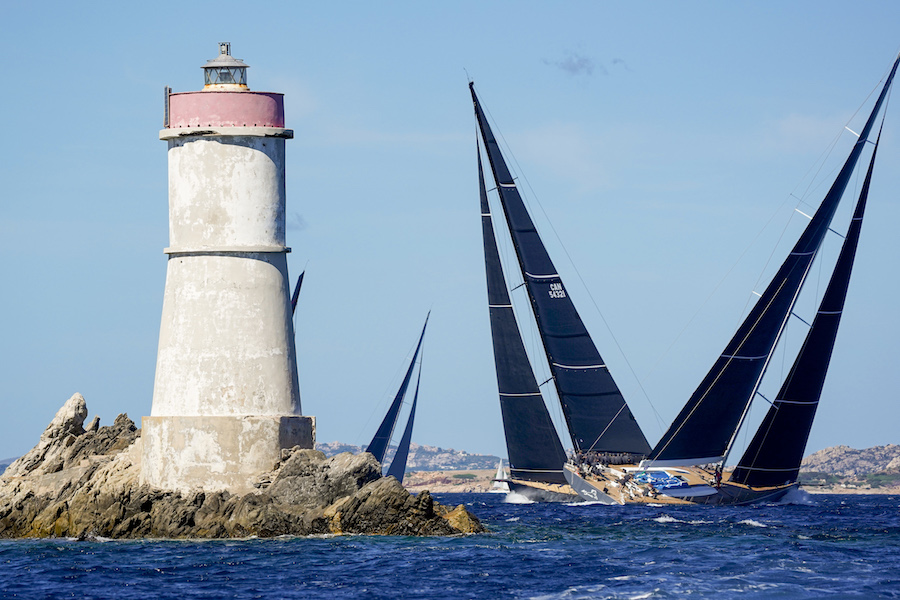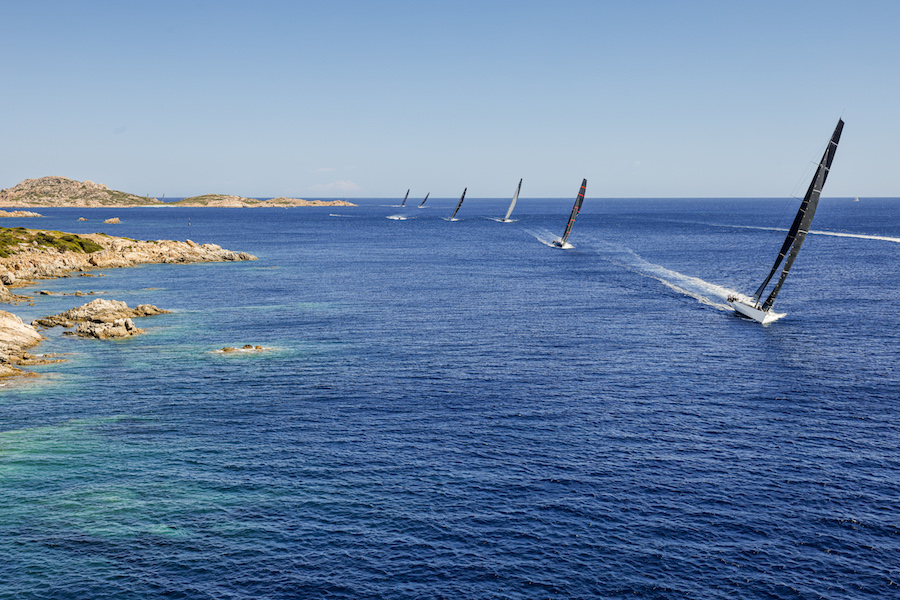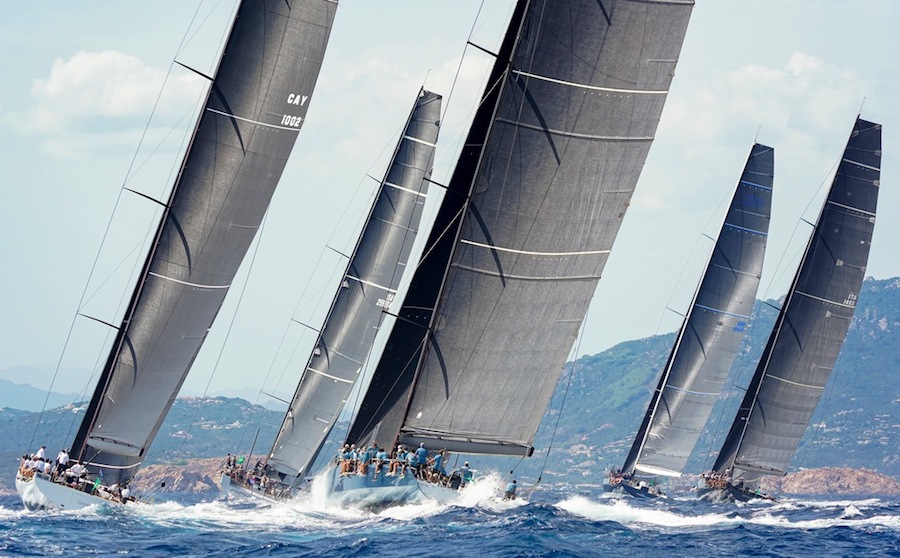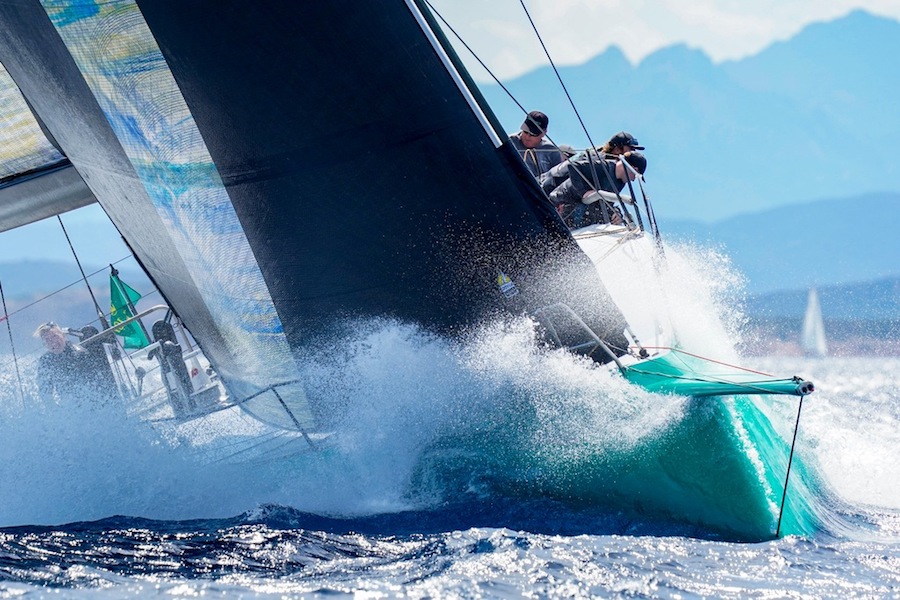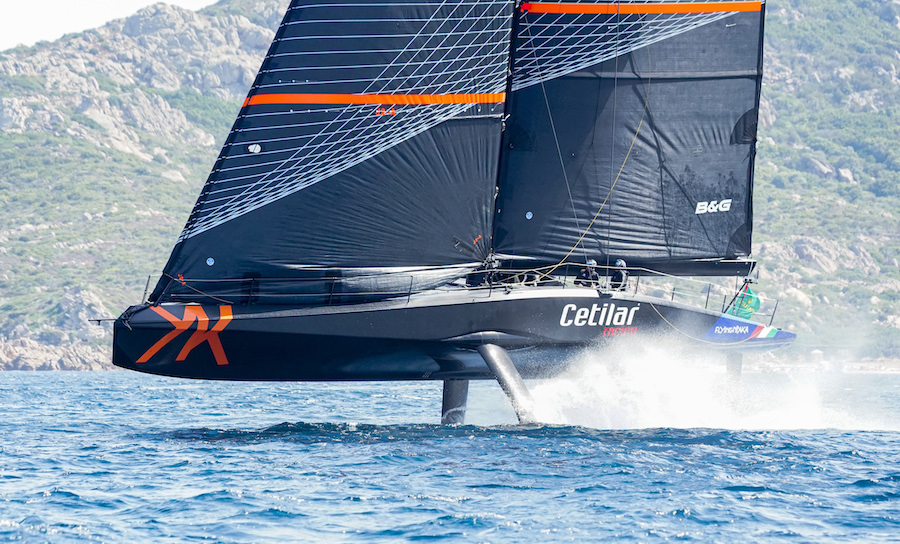The Maxi Yacht Rolex Cup produced world-class racing in Porto Cervo. After a week of intense competition, Highland Fling XI won the Maxi class. This was to be Irvine Laidlaw’s last blast on “Fling” as she moves on to join her new sailing team. Irvine reflects on yet another successful regatta at the helm.
Other class victors were: Vesper in Mini Maxi 1, Svea in J Class, Shamanna in Supermaxi, Capricorno in Mini Maxi 2 and H20 in Mini Maxi 3/4. See full results here.
An impressive fleet
Organised by the Yacht Club Costa Smeralda (YCCS), in conjunction with the International Maxi Association (IMA), the Maxi Yacht Rolex Cup dates back to 1980. The partnership with title sponsor Rolex began in 1984.
The 32nd edition of the annual gathering of imposing monohulls attracted a 50-strong fleet ranging in size from 18 metres (60 feet) to 43.5 m (143ft) and in age from the 89-year-old Velsheda to FlyingNikka, just launched in May. These two yachts are the very antithesis of each other in virtually every respect, except their originating concept: to be the fastest, cutting-edge racer of their period.
A last Fling
Irvine Laidlaw reflects on his last Maxi Yacht Rolex Cup at the helm of the RP82, Highland Fling XI.
“Still smarting at having lost the 2021 Rolex Maxi event due to a brand new Carbospars forestay having given way, Highland Fling XI (HF) was back to fight for the 2022 event. This was our last chance of going out on a high, the boat having been sold with delivery after the regatta.
The 13 strong entry list in our class was impressive; and included all the usual suspects (Magic Carpet, Deep Blue, Y3K, Rambler 88, Grandeorazio, Galateia) plus the new Juan K Swan 80, My Song (Pigi Loro Piana). We were clear that this wasn’t going to be an easy win.
Forecasts for the week were all over the place with light, medium and strong winds. Fortunately HF is not weak in any condition (unlike the canting keelers Rambler 88 and My Song), so we rather welcomed a variety of wind strengths.
HF’s crew were as good as we have ever had on the boat. Cam Appleton did tactics with regular navigator, Capey, keeping us (successfully) off the many rocks around the Costa Smeralda coast. All the other 22 crew had sailed on HF many times before, so it was a well melded and efficient bunch of sailors.
Courses were four days of coastal racing plus a day of two windward-leeward’s (W-L). I haven’t done W-Ls for many years, and HF is not set up for these, so day 3 was going to be my biggest concern.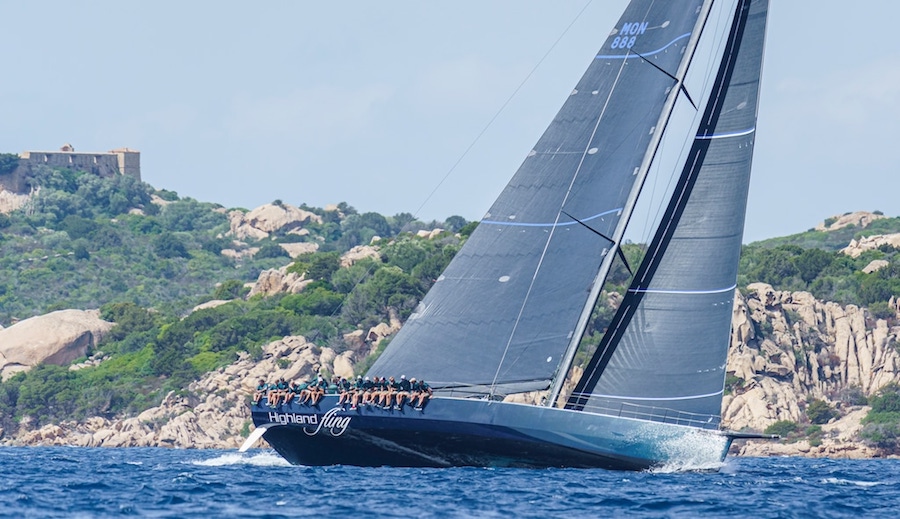
Consistency is key
Our rating is good, as we can benefit from an age allowance for a 13 year old boat. Since building the boat in the US, we have made no major modications other than stripping out the interior. The mast is the original from Southern Spars, the teak has been replaced by Seadek, but anyone would look at the boat and recognise the original from the launch in Newport, RI. Sails are constantly replaced with a wardrobe from North, Quantum and Doyle. I like to ring the changes to keep the sailmakers on their toes.
Race 1 was in 14 – 16 knots with not too much reaching (that benefits the canting keel boats). We won by 1 minute on corrected time from the well sailed 100’ Wally Cento Galateia.
Race 2 was a gift to the smaller and slower boats as we brought breeze down to the finish. With a third place, we were still the top boat.
I surprised myself, although probably not the crew, in winning the first windward-leeward on day 3. On the second race we had a bad gennaker hoist due to the sail being twisted on a gybe set at the bottom mark. That lost us about 45 seconds so a third felt like a special treat. We were now leading by 8 points. Consistency always is the way to win regattas, particularly with no discards.
Day 4 was laid on for the benefit of the two canting keel boats with long reaches in 20 knot winds. We used our always-impressive cuben-fibre FRO on the 5 mile run from Monaci to Mortorietto. We enjoyed fantastic sailing with boat speeds reaching 26 knots; HF is easy to helm in these conditions with twin rudders. A real joy. But not fast enough to beat the canting keels so we got a third on that day. Fortunately My Song and Rambler were low scorers on other days so we were now 7 points ahead.
The final day was forecast to be a strong Mistral from the west, so an early start was scheduled to try to get a race in before it really pumped up. We went out to the start in 18 knots which rapidly rose to 24 knots. Still raceable at that point. Hoisting the J4 at the five minute gun resulted in an unrepairable tear on the luff, so we quickly got the J3 up. Way less than ideal with gusts now up to 28 knots. But luck was on our side with the AP flag going up 30 seconds before the start.
There were big cheers on HF as that meant that we were very happy winners. It’s my fifth victory at the Maxi Yacht Rolex Cup, with the last win in 2019, and now Highland Fling XI leaves my ownership in a blaze of glory”!
Classy Js
Unveiled in 1933, at the time, the J Class Velsheda represented the most advanced technical design in spars, rigging, sails, deck gear, halyards and control lines. Her mast was formed from aluminium plates riveted together. The sails relied on the latest synthetic polyester fibre threads and sheets benefited from winches. Over recent decades, Velsheda has evolved through modernizing refits to incorporate elements of today’s yachting. More comfortable below, significantly she performs to the best of her potential. A regular on the race circuit since the late 1990s, Velsheda won class in Porto Cervo on three occasions in 2009, 2019 and 2021.
This year, however, it was the superbly sailed Svea that outgunned the opposition to win the J Class comfortably. Velsheda came third, one point behind Ranger after six races. Bouwe Bekking, the round the world yachtsman, already a serial winning tactician at the Maxi Yacht Rolex Cup on the Supermaxi Nilaya in 2011, 2012 and 2013, and the J Class Lionheart in 2014, was in the afterguard of Svea. Bekking explained the attraction of racing a more traditional design:
“I think it is the most majestic yacht you can ever race on. There is so much heritage. It is huge challenge to get a J around the track, it takes a team of 35, which needs a lot of training to be able to work together. There is a massive sail area to handle during mark roundings, and huge spinnaker poles. Every person onboard has a job, one tiny mistake by anyone will reflect in the overall performance.”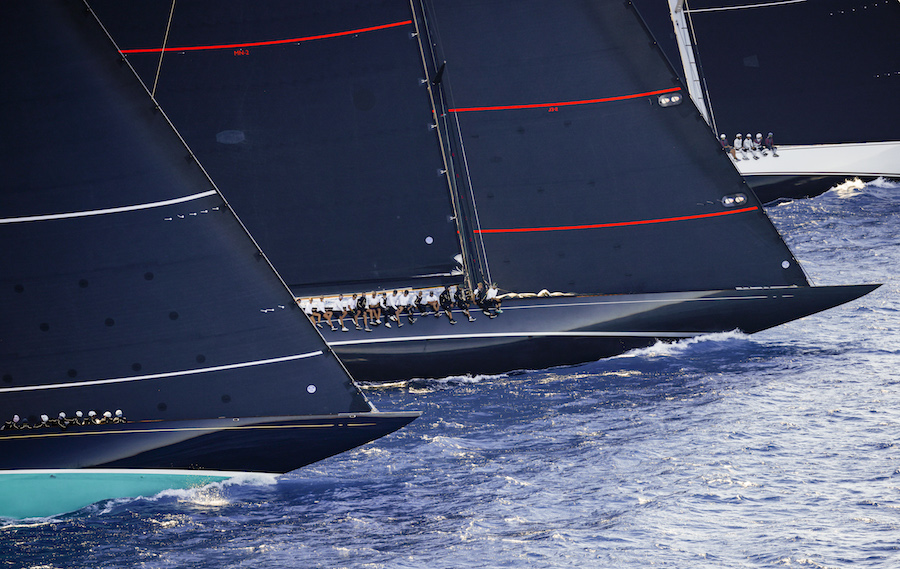
Flying action
FlyingNikka is at the opposite extreme of the classic Js. Influenced by the AC75, first introduced at the 2021 America’s Cup, the forward-looking foiling Maxi was designed by Mark Mills, whose boats have won regularly at the Maxi Yacht Rolex Cup and on the international circuit. Mark also designed the Cape 31, the nippy sports boat fast growing in popularity around the world (18 boats competed in Cowes Week this year). Moving the concept to reality, required the unstinting commitment of owner Roberto Lacorte, a four-time winner at this regatta. Drawing on the latest aerodynamic thinking and construction engineering, she was built as light and reliable as possible to sail in a wide range of conditions. The foil configuration has benefited from simulator research, while the wing sail articulation is custom-made to withstand the rigours of offshore racing. So innovative is FlyingNikka that she raced alone, a virtual demonstration class, revealing the possibilities and a reminder that design evolution is perpetual.
Watch the regatta highlights below.

